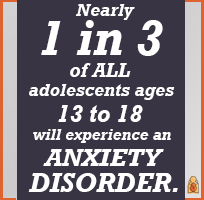By: Claire McCarthy, MD, FAAP
According to the National Institutes of Health, nearly
1 in 3 of all adolescents ages 13 to 18 will experience an anxiety disorder. These numbers have been rising steadily; between 2007 and 2012, anxiety disorders in children and teens
went up 20%.
These stats combined with the rate of hospital admissions for suicidal teenagers also
doubling over the past decade leaves us with
many concerning questions.
 What's causing the rise in teenagers with severe anxiety? How did we get here?
What's causing the rise in teenagers with severe anxiety? How did we get here?
What's going on? While we don't know for sure, there are a number of factors that could be contributing. In addition to genetics, brain chemistry, personality, and life events, take the following into consideration:
-
High expectations and pressure to succeed. Between standardized testing and a
culture of achievement, today's youth can feel pressure to succeed in ways previous generations did not. A survey done every year by
Higher Education Research asks incoming college freshmen if they feel overwhelmed by all they have to do. In 2016, 41% of students said "yes" compared with 28% in 2000 and 18% in 1985.
A world that feels scary and threatening. We've seen an increase in school shootings, with resultant
drills and lockdowns in schools. We've seen shootings in public places. There have been terrorist attacks here in the US and around the world taking many lives. From just
watching or reading the news, it is reasonable for anyone to feel afraid in public spaces that previously would have felt safe.
Social media. Today's children and teens are
constantly connected to social media. It's not surprising that their self-esteem―and worldview ―becomes connected to responses to social media posts. It's hard for them not to compare their life and social connections to what they see others posting on social media.
There are also some children who have unexpected and disproportionate reactions to normal developmental experiences like going to school, going to a party, doing a sleepover or going to camp; children who worry excessively about everyday life activities. This often starts in the years right before
puberty.
Whatever the cause, this rise in anxiety is a real problem for our youth.
Chronic anxiety can lead to serious mental health problems―depression,
substance use, and
even suicide. It can interfere with the ability to focus and learn causing school problems that can have lifelong impact. It can also lead to physical problems, such as headaches, chronic pain, digestive problems, and later heart disease.
Anxiety disorders cut across all demographics―suburban, urban, and rural. They affect those who are
college-bound and those who are not.
So, what can parents, teachers, and anyone else who interacts with children and teens do?
Be aware of the signs of anxiety. Sometimes children may say that they are anxious, but other times it is less clear―especially as they may not even realize it themselves. Signs can include:
Recurring fears and worries abo ut routine parts of every day life
Changes in behavior, such as irritability
Avoiding activities, school, or social interactions
Dropping grades or school avoidance
Trouble sleeping or concentrating
Substance use or other risky behaviors
Chronic physical complaints, such as fatigue, headaches, or stomachaches.
Talk with kids about potential stressors. Try to see the world the way they do—and help them to keep perspective and find ways to cope.
Be mindful of the expectations you set for children and teens. High expectations can help children reach their potential, but they need to be realistic ones. Not only that, remember that kids need time to relax, play, and be with friends—all of which are crucial for their mental and physical health. And it's important for all of us to remember that there is more to life than achievement.
Talk with kids about their social media use. Help them take breaks—and help them think critically and rationally about the effect of social media on their lives.
See
How to Connect with Your Teen about Smart & Safe Media Use.
How pediatricians screen kids for anxiety:
At visits―whether they are
well child visits or appointments made because of a concern―pediatricians ask questions about a child's physical complaints, mood, behavior and activities, as well as what is going on at school, at home, and in other areas of life.
Pediatricians also use screening tools such as the
Pediatric Symptom Checklist (PSC) that look for signs of various different mental health problems, including anxiety. Pediatricians often refer to
mental health professionals, as well, in order to more fully evaluate children when there is a concern.
Know anxiety is treatable!
According to the
Anxiety and Depression Association of America, 80% of kids with a diagnosable anxiety disorder are not getting treatment―and anxiety disorders are highly treatable! As with most problems, the earlier it is diagnosed the easier it is to treat.
The
most effective treatments with for anxiety disorders are cognitive‐behavioral therapy (CBT) and SSRI medications.
CBT focuses on changing how the child thinks about his fear, increasing exposure to feared situations, and relaxation strategies such as deep breathing, muscle relaxation, and positive self‐talk (repeating positive or reassuring statements to oneself). Exposure therapy, a type of CBT, focuses on increasing exposure to feared objects or activities.
SSRIs (selective serotonin reuptake inhibitors) ―commonly prescribed antidepressants―are the medications most frequently used for treating anxiety disorders in children.
Studies have found a combination of CBT and medication for 12 weeks yields a positive response in 80% of children with anxiety disorders. In fact, 65% of those children had no or minimal anxiety symptoms after the 12 weeks of treatment. With CBT alone, 60% had a positive response―about 35% of those children having no or minimal anxiety symptoms. However, it is important to note that SSRI medications can be administered safely and be an important part of child's anxiety disorder treatment.
As with any mental health disorder, anything that supports general wellbeing is an important part of anxiety disorder treatment―regular sleep, exercise,
meditation, relaxation apps or
yoga can be helpful. However, these are not a substitute for CBT or medication.
The most important thing is to be aware of your children's mental health, ask questions, and ask for help!
Additional Information:
About Dr. McCarthy:
 Claire McCarthy, MD, FAAP is a primary care pediatrician at Boston Children's Hospital, an Assistant Professor of Pediatrics at Harvard Medical School, a senior editor for Harvard Health Publications, and an official spokesperson for the American Academy of Pediatrics. She writes about health and parenting for the
Harvard Health Blog, Huffington Post and many other online and print publications.
Claire McCarthy, MD, FAAP is a primary care pediatrician at Boston Children's Hospital, an Assistant Professor of Pediatrics at Harvard Medical School, a senior editor for Harvard Health Publications, and an official spokesperson for the American Academy of Pediatrics. She writes about health and parenting for the
Harvard Health Blog, Huffington Post and many other online and print publications.